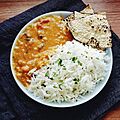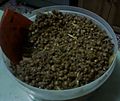Pigeon pea facts for kids
Quick facts for kids Pigeon pea |
|
|---|---|
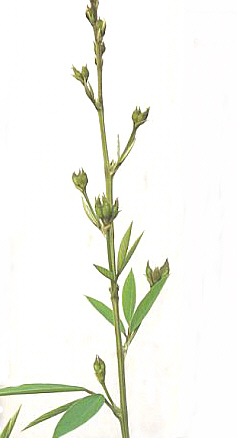 |
|
| Scientific classification | |
| Genus: |
Cajanus
|
| Species: |
cajan
|
The pigeon pea (Cajanus cajan) is also known as arhar, tur, red gram, or gungo peas. It is a type of legume plant that lives for many years and belongs to the Fabaceae family.
People in India started growing pigeon peas at least 3,500 years ago. Since then, its seeds have become a popular food in Asia, Africa, and Latin America. It is eaten a lot in South Asia and is a main source of protein for people in the Indian subcontinent. It is often eaten with rice or roti (a type of flat bread) and is a very important staple food across India.
Contents
Where Pigeon Peas Come From
Pigeon peas have been grown for at least 3,500 years. They likely first grew in India, where their wild relatives are found in tropical forests.
Scientists have found old pigeon pea seeds from about 3,400 years ago (around 1400 BC). These were found at ancient sites in places like Kalaburagi in Karnataka, Tuljapur Garhi in Maharashtra, and Gopalpur in Odisha. From India, pigeon peas traveled to East and West Africa. Europeans first saw them there and called them "Congo Pea." Later, during the slave trade, they came to the Americas, probably in the 1600s.
How Pigeon Peas Are Grown
Today, pigeon peas are grown widely in warm and partly warm areas all over the world.
About 4.49 million tons of pigeon peas are grown worldwide each year. India produces about 63% of this amount. Africa is the second largest producer, making about 21% of the world's supply. Malawi, Tanzania, Kenya, Mozambique, and Uganda are the main producers in Africa.
Around 5.4 million hectares of land are used to grow pigeon peas. India uses about 72% of this land, which is 3.9 million hectares.
Pigeon peas are an important crop for farms that rely only on rain, especially in dry, warm regions. India, eastern Africa, and Central America are the top three areas for growing pigeon peas. They are grown in over 25 tropical and subtropical countries. Farmers grow them alone or mixed with other crops like sorghum, pearl millet, maize, or peanuts.
Pigeon pea plants are special because they work with tiny helpers called Rhizobia bacteria. These bacteria live in the plant's roots and help add nitrogen to the soil. This makes the soil richer and better for growing other plants.
Pigeon peas can be grown as plants that live for three to five years (perennial). However, they produce fewer seeds after the first two years. There are also types that live for only one year (annual), which are better for producing seeds.
Farmers who don't have many resources often grow pigeon peas on less fertile land. They usually plant traditional types that take a long time to grow (5–11 months). Recently, new types that grow faster (3–4 months) have been developed, which are good for growing multiple crops in a year. Farmers usually use very little fertilizer, weeding, water, or bug spray. Because of this, the amount of pigeon peas harvested is often low (about 700 kg per hectare). However, since pigeon peas are in high demand and sell for good prices, farmers are now paying more attention to growing them well.
Pigeon peas can handle dry weather very well. They can grow in areas that get less than 650 mm of rain each year. In dry parts of Kenya, the maize crop often fails. So, a group called the International Crops Research Institute for the Semi-Arid Tropics (ICRISAT) is helping farmers grow pigeon peas instead. Pigeon peas are good because they can survive droughts and are very nutritious.
John Spence, a scientist and politician from Trinidad and Tobago, created new types of short pigeon pea plants. These can be harvested by machines, which makes farming easier than harvesting by hand.
Preparing Pigeon Pea Seeds
Removing the Outer Skin
In India, people have been removing the outer skin (dehulling) from pigeon peas for a very long time. In the past, people would pound them by hand. There are two main traditional ways to do this:
Wet Method
This method involves soaking the pigeon peas in water, drying them in the sun, and then removing the skin.
Dry Method
This method involves putting a little oil or water on the peas, drying them in the sun, and then removing the skin. For large amounts of pigeon peas, machines are used in mills to remove the skin and split them. This split, skinless version is called toor dal in Hindi.
Uses of Pigeon Peas
Pigeon peas are used both as a food crop and as a plant to cover the ground or feed animals. As a food, they can be eaten as dried peas, made into flour, or eaten as green vegetable peas.
When pigeon peas are eaten with cereals, they make a very healthy and balanced meal. Nutritionists often suggest them for balanced diets. You can also sprout the dried peas for a short time and then cook them. This gives them a different flavor and makes them easier to digest. Sprouting helps reduce sugars that are hard to digest in the cooked dried peas.
In India, pigeon peas are one of the most popular pulses. They are a key source of protein for many people who eat mostly vegetarian diets. In places where they grow, the fresh young pods are eaten as a vegetable in dishes like sambar. Whole pigeon peas are called arhar dal in Hindi. In Ethiopia, people cook and eat not only the pods but also the young shoots and leaves.
In some places, like the Caribbean coast of Colombia, the Dominican Republic, Panama, and Hawaii, pigeon peas are grown to be canned and eaten. A dish made of rice and green pigeon peas, called moro de guandules, is a traditional food in the Dominican Republic. Pigeon peas are also made into a stew with plantain balls. In Puerto Rico, arroz con gandules is a traditional dish made with rice and pigeon peas, especially popular during Christmas. Jamaica also uses pigeon peas instead of kidney beans in their rice and peas dish, especially at Christmastime. Trinidad and Tobago and Grenada have their own version called pelau, which includes beef or chicken, and sometimes pumpkin and cured pig tail. In the Atlántico department of Colombia, a soup called sopa de guandú con carne salada is made with pigeon peas.
In The Bahamas, people use the light brown dried pigeon peas (not the fresh green ones) to make a hearty dish called "Peas 'n Rice." This dish is made by cooking pork fatback, onions, sweet pepper, and spices. Tomatoes and tomato paste are added, then water, peas, and rice. It is slow-boiled until tender. The dish turns a medium-dark brown color, and the pigeon peas become even darker, adding a nice contrast.
In Thailand, pigeon peas are grown to host tiny insects that produce lac. Lac is a sticky substance used to make shellac, which is used for varnishes and polishes.
Pigeon peas are also an important crop for green manure in some areas. This means they are grown and then plowed back into the soil to make it healthier. They can add up to 90 kg of nitrogen per hectare. The strong, woody stems of pigeon pea plants can also be used as firewood, for building fences, and for making roofs (thatch).
Pigeon peas are an important part of animal feed in West Africa, especially in Nigeria. Leaves, pods, seeds, and leftover parts from processing the seeds are all used to feed different kinds of farm animals.
In the Western Visayas region of the Philippines, pigeon peas, known locally as "kadyos," are the main ingredient in a popular dish called "KBL." This name stands for "Kadyos" (pigeon pea), "Baboy" (pork), and "Langka" (jackfruit). It is a savory soup with rich flavors from the pigeon peas, smoked pork (often the legs or tail), and a souring agent called "batuan." Raw jackfruit is chopped and boiled until soft, adding bulk to the soup. The soup often has a violet color from the type of pigeon pea commonly grown there.
Pigeon Pea's Genetic Map
The pigeon pea was the first seed legume plant to have its entire genetic map (genome) read. This was first done by a group of 31 Indian scientists. After that, a global team called the International Initiative for Pigeonpea Genomics (IIPG) continued the work. This team was led by ICRISAT and included partners from China, the US, and Europe. This was the first time a research center supported by CGIAR (a global research partnership) led the genome sequencing of a food crop.
Nutrition
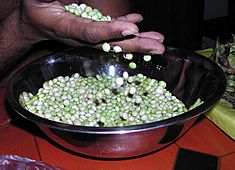
Pigeon peas in Trinidad and Tobago
|
|
| Nutritional value per 100 g (3.5 oz) | |
|---|---|
| Energy | 569 kJ (136 kcal) |
|
23.88 g
|
|
| Sugars | 3 g |
| Dietary fiber | 5.1 g |
|
1.64 g
|
|
|
Protein
|
7.2 g
|
| Vitamins | Quantity
%DV†
|
| Thiamine (B1) |
35%
0.4 mg |
| Riboflavin (B2) |
14%
0.17 mg |
| Niacin (B3) |
14%
2.2 mg |
| Pantothenic acid (B5) |
14%
0.68 mg |
| Vitamin B6 |
5%
0.068 mg |
| Folate (B9) |
43%
173 μg |
| Choline |
9%
45.8 mg |
| Vitamin C |
47%
39 mg |
| Vitamin E |
3%
0.39 mg |
| Vitamin K |
23%
24 μg |
| Minerals | Quantity
%DV†
|
| Calcium |
4%
42 mg |
| Iron |
12%
1.6 mg |
| Magnesium |
19%
68 mg |
| Manganese |
27%
0.574 mg |
| Phosphorus |
18%
127 mg |
| Potassium |
18%
552 mg |
| Sodium |
0%
5 mg |
| Zinc |
11%
1.04 mg |
|
Link to USDA Database entry
Values for Choline, Vit. E/K available |
|
| †Percentages estimated using US recommendations for adults. | |
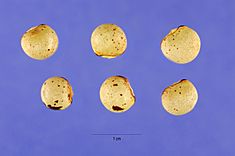
Seeds of the pigeon pea
|
|
| Nutritional value per 100 g (3.5 oz) | |
|---|---|
| Energy | 1,435 kJ (343 kcal) |
|
62.78 g
|
|
| Sugars | n/a |
| Dietary fiber | 15 g |
|
1.49 g
|
|
|
Protein
|
21.7 g
|
| Tryptophan | 212 mg |
| Threonine | 767 mg |
| Isoleucine | 785 mg |
| Leucine | 1549 mg |
| Lysine | 1521 mg |
| Methionine | 243 mg |
| Cystine | 250 mg |
| Phenylalanine | 1858 mg |
| Tyrosine | 538 mg |
| Valine | 937 mg |
| Arginine | 1299 mg |
| Histidine | 774 mg |
| Alanine | 972 mg |
| Aspartic acid | 2146 mg |
| Glutamic acid | 5031 mg |
| Glycine | 802 mg |
| Proline | 955 mg |
| Serine | 1028 mg |
| Hydroxyproline | 0 mg |
| Vitamins | Quantity
%DV†
|
| Thiamine (B1) |
56%
0.643 mg |
| Riboflavin (B2) |
16%
0.187 mg |
| Niacin (B3) |
19%
2.965 mg |
| Pantothenic acid (B5) |
25%
1.266 mg |
| Vitamin B6 |
22%
0.283 mg |
| Folate (B9) |
114%
456 μg |
| Choline |
0%
0.000000 mg |
| Vitamin C |
0%
0 mg |
| Vitamin E |
0%
0.000000 mg |
| Vitamin K |
0%
0.000000 μg |
| Minerals | Quantity
%DV†
|
| Calcium |
13%
130 mg |
| Iron |
40%
5.23 mg |
| Magnesium |
52%
183 mg |
| Manganese |
85%
1.791 mg |
| Phosphorus |
52%
367 mg |
| Potassium |
46%
1392 mg |
| Sodium |
1%
17 mg |
| Zinc |
29%
2.76 mg |
|
Link to USDA Database entry
Values for Choline, Vit. E/K unavailable |
|
| †Percentages estimated using US recommendations for adults. | |
Pigeon peas are packed with protein and important amino acids like methionine, lysine, and tryptophan. Amino acids are the building blocks of protein, which our bodies need to grow and repair themselves.
The table below shows how complete the protein in mature pigeon pea seeds is, based on different amino acids:
| Essential Amino Acid | Available mg/g of Protein | Min. Required mg/g of Protein |
|---|---|---|
| Tryptophan | 9.76 | 7 |
| Threonine | 32.34 | 27 |
| Isoleucine | 36.17 | 25 |
| Leucine | 71.3 | 55 |
| Lysine | 70.09 | 51 |
| Methionine+Cystine | 22.7 | 25 |
| Phenylalanine+Tyrosine | 110.4 | 47 |
| Valine | 43.1 | 32 |
| Histidine | 35.66 | 18 |
The combination of Methionine and Cystine is the only amino acid mix that is slightly low in pigeon peas compared to what our bodies need. Young, immature pigeon peas generally have lower nutritional values than mature seeds. However, they contain a good amount of vitamin C (39 mg per 100 g serving) and have a bit more fat. Research shows that the protein in immature seeds is of a higher quality.
| Protein | Fiber | Vitamins | Minerals | |||||||||||||||||||||||
|---|---|---|---|---|---|---|---|---|---|---|---|---|---|---|---|---|---|---|---|---|---|---|---|---|---|---|
| Food | DV | Q | DV | A | B1 | B2 | B3 | B5 | B6 | B9 | B12 | Ch. | C | D | E | K | Ca | Fe | Mg | P | K | Na | Zn | Cu | Mn | Se |
| cooking Reduction % | 10 | 30 | 20 | 25 | 25 | 35 | 0 | 0 | 30 | 10 | 15 | 20 | 10 | 20 | 5 | 10 | 25 | |||||||||
| Corn | 20 | 55 | 6 | 1 | 13 | 4 | 16 | 4 | 19 | 19 | 0 | 0 | 0 | 0 | 0 | 1 | 1 | 11 | 31 | 34 | 15 | 1 | 20 | 10 | 42 | 0 |
| Rice | 14 | 71 | 1.3 | 0 | 12 | 3 | 11 | 20 | 5 | 2 | 0 | 0 | 0 | 0 | 0 | 0 | 1 | 9 | 6 | 7 | 2 | 0 | 8 | 9 | 49 | 22 |
| Wheat | 27 | 51 | 40 | 0 | 28 | 7 | 34 | 19 | 21 | 11 | 0 | 0 | 0 | 0 | 0 | 0 | 3 | 20 | 36 | 51 | 12 | 0 | 28 | 28 | 151 | 128 |
| Soybean(dry) | 73 | 132 | 31 | 0 | 58 | 51 | 8 | 8 | 19 | 94 | 0 | 24 | 10 | 0 | 4 | 59 | 28 | 87 | 70 | 70 | 51 | 0 | 33 | 83 | 126 | 25 |
| Pigeon pea(dry) | 42 | 91 | 50 | 1 | 43 | 11 | 15 | 13 | 13 | 114 | 0 | 0 | 0 | 0 | 0 | 0 | 13 | 29 | 46 | 37 | 40 | 1 | 18 | 53 | 90 | 12 |
| Potato | 4 | 112 | 7.3 | 0 | 5 | 2 | 5 | 3 | 15 | 4 | 0 | 0 | 33 | 0 | 0 | 2 | 1 | 4 | 6 | 6 | 12 | 0 | 2 | 5 | 8 | 0 |
| Sweet potato | 3 | 82 | 10 | 284 | 5 | 4 | 3 | 8 | 10 | 3 | 0 | 0 | 4 | 0 | 1 | 2 | 3 | 3 | 6 | 5 | 10 | 2 | 2 | 8 | 13 | 1 |
| Spinach | 6 | 119 | 7.3 | 188 | 5 | 11 | 4 | 1 | 10 | 49 | 0 | 4.5 | 47 | 0 | 10 | 604 | 10 | 15 | 20 | 5 | 16 | 3 | 4 | 6 | 45 | 1 |
| Dill | 7 | 32 | 7 | 154 | 4 | 17 | 8 | 4 | 9 | 38 | 0 | 0 | 142 | 0 | 0 | 0 | 21 | 37 | 14 | 7 | 21 | 3 | 6 | 7 | 63 | 0 |
| Carrots | 2 | 9.3 | 334 | 4 | 3 | 5 | 3 | 7 | 5 | 0 | 0 | 10 | 0 | 3 | 16 | 3 | 2 | 3 | 4 | 9 | 3 | 2 | 2 | 7 | 0 | |
| Guava | 5 | 24 | 18 | 12 | 4 | 2 | 5 | 5 | 6 | 12 | 0 | 0 | 381 | 0 | 4 | 3 | 2 | 1 | 5 | 4 | 12 | 0 | 2 | 11 | 8 | 1 |
| Papaya | 1 | 7 | 5.6 | 22 | 2 | 2 | 2 | 2 | 1 | 10 | 0 | 0 | 103 | 0 | 4 | 3 | 2 | 1 | 2 | 1 | 7 | 0 | 0 | 1 | 1 | 1 |
| Pumpkin | 2 | 56 | 1.6 | 184 | 3 | 6 | 3 | 3 | 3 | 4 | 0 | 0 | 15 | 0 | 5 | 1 | 2 | 4 | 3 | 4 | 10 | 0 | 2 | 6 | 6 | 0 |
| Sunflower oil | 0 | 0 | 0 | 0 | 0 | 0 | 0 | 0 | 0 | 0 | 0 | 0 | 0 | 205 | 7 | 0 | 0 | 0 | 0 | 0 | 0 | 0 | 0 | 0 | 0 | |
| Egg | 25 | 136 | 0 | 10 | 5 | 28 | 0 | 14 | 7 | 12 | 22 | 45 | 0 | 9 | 5 | 0 | 5 | 10 | 3 | 19 | 4 | 6 | 7 | 5 | 2 | 45 |
| Milk | 6 | 138 | 0 | 2 | 3 | 11 | 1 | 4 | 2 | 1 | 7 | 2.6 | 0 | 0 | 0 | 0 | 11 | 0 | 2 | 9 | 4 | 2 | 3 | 1 | 0 | 5 |
| Chicken Liver | 34 | 149 | 0 | 222 | 20 | 105 | 49 | 62 | 43 | 147 | 276 | 30 | 0 | 4 | 0 | 1 | 50 | 5 | 30 | 7 | 3 | 18 | 25 | 13 | 78 | |
| %DV = % daily value i.e. % of DRI (Dietary Reference Intake)
Note: All nutrient values including protein and fiber are in %DV per 100 grams of the food item. Significant values are highlighted in light Gray color and bold letters. Cooking reduction = % Maximum typical reduction in nutrients due to boiling without draining for ovo-lacto-vegetables group Q = Quality of Protein in terms of completeness without adjusting for digestability. |
||||||||||||||||||||||||||
Images for kids
-
Dried pigeon peas next to a ruler from the Ereke market in Buton Island, Indonesia.
-
Pigeon peas or "Gandules" harvested from Baracoa, Cuba.
-
Pigeon pea seedpods at Community Garden Sand Island, Midway Atoll, Hawaii.
-
Wild pigeon peas growing on Cha das Caldeiras on Fogo island in Cape Verde.
-
Jamaican jerk chicken with a side of Rice and peas.
-
A traditional meal from Uttarakhand with rice, pigeon pea dal, homemade butter, and whey.
-
A small girl standing near Dholl crop (pigeon pea) in George Brown Darwin Botanic Gardens around 1905.
See also
 In Spanish: Guandú para niños
In Spanish: Guandú para niños







